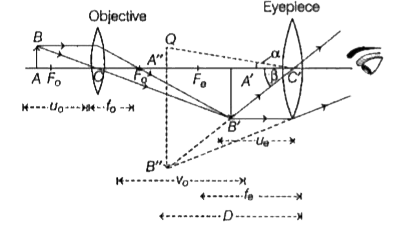Draw a ray diagram to show the formation of final image at the least distance of distance vision by a compound microscope.
When the image is formed at near point,
{∵fe is the focal length of eyepiece}

Similar Questions
Draw a neat labelled ray diagram showing the formation of an image at the least distance of distinct vision D by a simple microscope. When the final image is at D, derive an expression for its magnifying power at D.
View SolutionDraw ray diagrams showing the image formation by a concave lens when an object is placed
(a) between focus and twice the focal length of the lens
(b) beyond twice the focal length of the lens
View Solution
Draw a ray diagram to show the formation of the image as specified in the part a.
View SolutionDraw a ray diagram to show image formation by a concave lens.
View Solution(a) Draw a labelled ray diagram showing the formation of a final image by a compound microscope at least distance of distinct vision.
(b) The total magnification produced by a compound microscope is 20. The magnification produced by the piece is 5. The microscope is focussed on a certain object. The distance between the objective and eyepiece is observed to be 14cm. If least distance of distinct vision is 20cm, calculate the focal length of the objective and the eye piece.
View SolutionDraw a ray diagram of an astronomical telescope for the final image formed at least distance of distinct vision?
View Solution(a) Draw a labelled ray diagram showing the formation of a final image by a compound microscope at least distance of distinct vision.
(b) The total magnification produced by a compound microscope is 20. The magnification produced by the piece is 5. The microscope is focused on a certain object. The distance between the objective and eyepiece is observed to be 14cm. If least distance of distinct vision is 20cm, calculate the focal length of the objective and the eye piece.
View Solution(a) Draw a labelled ray diagram showing the formation of a final image by a compound microscope at least distance of distinct vision.
(b) The total magnification produced by a compound microscope is 20. The magnification produced by the piece is 5. The microscope is focused on a certain object. The distance between the objective and eyepiece is observed to be 14cm. If least distance of distinct vision is 20cm, calculate the focal length of the objective and the eye piece.
View Solution(a) Draw a labelled ray diagram showing the formation of a final image by a compound microscope at least distance of distinct vision.
(b) The total magnification produced by a compound microscope is 20. The magnification produced by the eyepiece is 5. The microscope is focussed on a certain object. The distance between the objective and eyepiece is observed to be 14 cm. If least distance of distinct vision is 20 cm, calculate the focal length of the objective and the eyepiece.
View SolutionDraw a ray diagram showing the formation of image of a point object by a plane mirror.
View Solution
